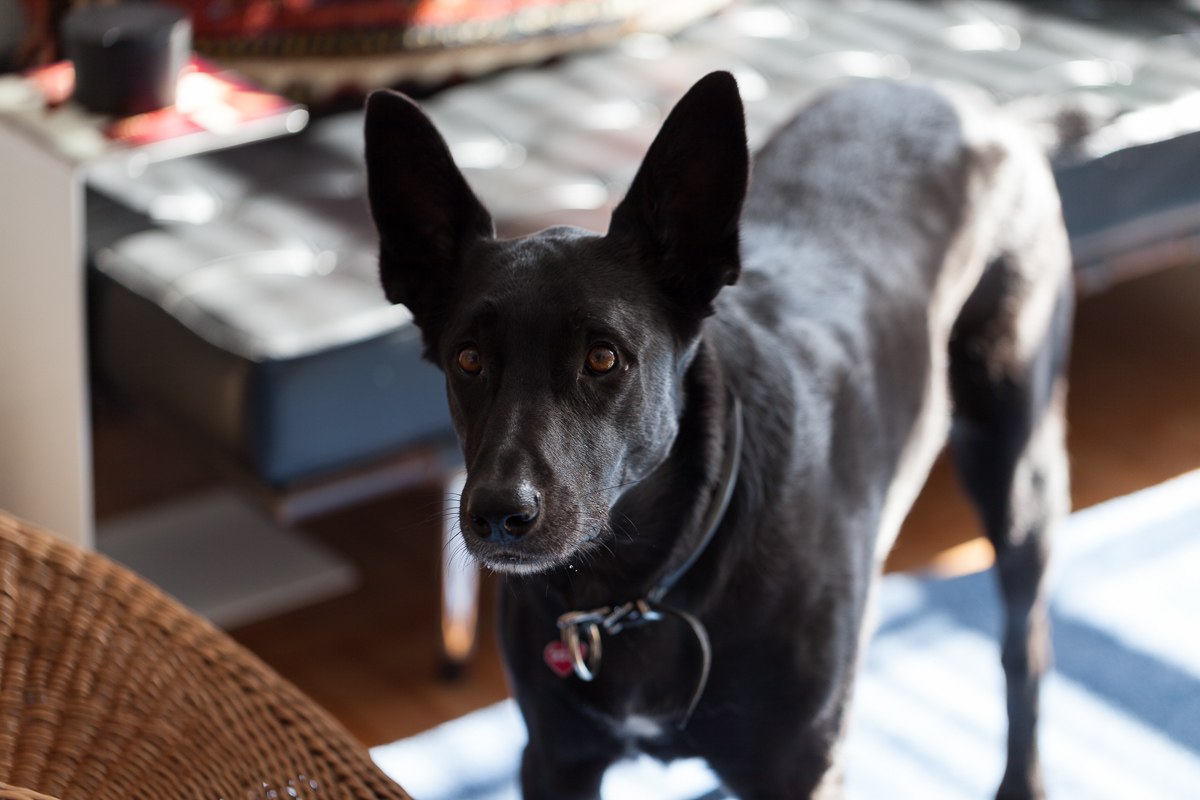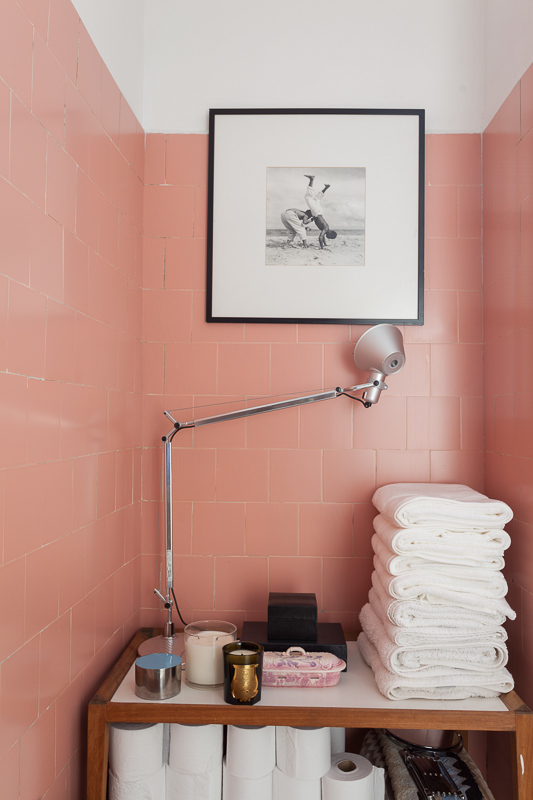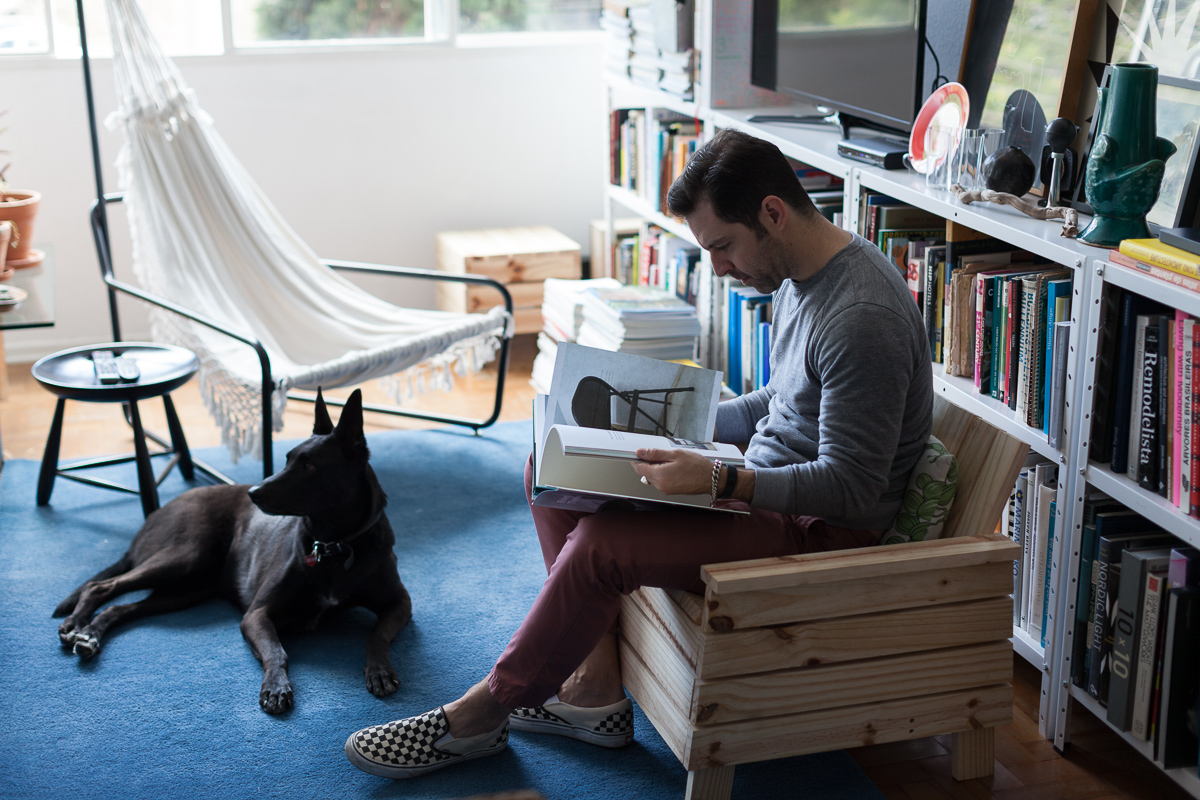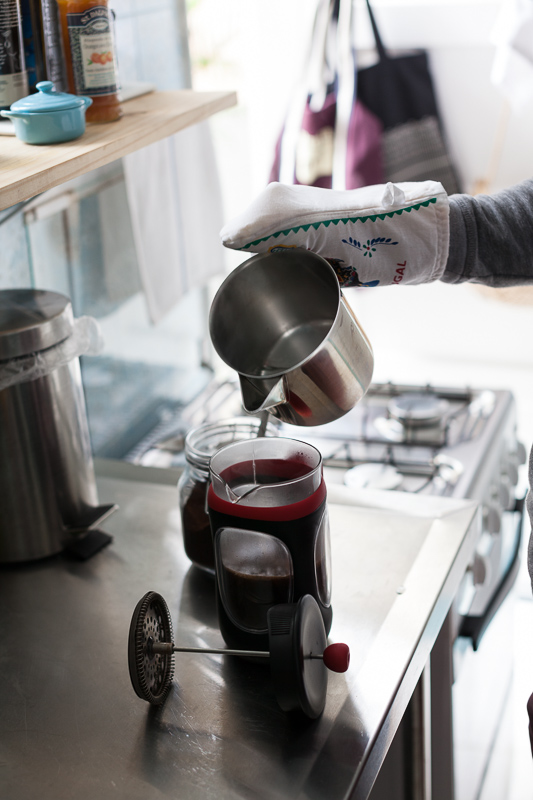Sometimes it doesn’t take more than a few words for someone’s passion for their work to come through, loud and clear. Brazilian architect and designer Maurício Arruda is one such person. Whether he’s talking about his influences, his big dreams, or contemporary consumer culture, he speaks with enthusiasm. He yearns to see Brazil emerge as a country known for its design as much as it is for carnival, football and the beach. There’s no doubt that he’s going to be leading the charge.
Maurício divides his time between his two concentrations – architecture and furniture – almost equally. While he’s relatively new to furniture design, he only formally started in 2010, from the beginning he’s raised important questions the recycling of materials, especially beautiful Brazilian hardwoods. Yet his focus for both is the same: sustainability and design that is more focused on process than mass production.
Maurício moved to São Paulo at the beginning of the noughties. There he shares his colorful, welcoming apartment with his loving half-Belgian Shepherd, half Rottweiler, Jaira. After almost 15 years, his vision has only gotten bigger and he’s experiencing the success to match it. Last year he teamed up with architect Guto Requena to tackle their big dreams – one of which is already in the works, their first residential building in the world’s eleventh largest metropolis.
This portrait is part of our ongoing collaboration with ZEIT Online who present a special curation of our pictures on ZEIT Magazin Online.






























Do you do more work in commercial and interior architecture, or furniture design?
I’m totally divided. On the architecture side, over the last few years I’ve gone more into commercial work. Previously, I did a lot of interior design, apartments and renovations. This year, the office formally split into two: one is a newly launched office for architecture and interior design with Guto Requena, who I’ve known since my studies. We started think what about doing hotels and residential buildings and realized that we had to merge our forces, our architects, our group, into one studio. The furniture and design company is still called Maurício Arruda.
Do you prefer one over the other?
They’re different. I don’t have a favorite. I think in architecture I’m starting to do the bigger things that I’ve dreamed of doing all my life. Guto and I are designing our first residential building in São Paulo and this is a huge challenge. We live in a mega city, and it’s very hard to get into the market. The challenge with architecture is that it’s getting bigger. This changes the way I see the architecture part of my life. When I finished university sustainability was just being approached in Brazil and was very difficult to put into practice because we did not have products or people who knew how to build green buildings. Since then, sustainability has become one of the most important aspects of things that I design, furniture or architecture.
How did you discover your talent for furniture design? Was it something you’ve always been interested in or did it come later?
It came later. In 2010 I started to design furniture, but it wasn’t a serious thing. It was more like an investigation of materials, of the culture on the streets, looking at what people use in other places and changing the context. I had some ideas, and I managed to make them happen.
What was your first piece?
The first piece I designed was Linha José, flexible storage furniture using plastic crates instead of drawers. It was a huge success on all the blogs. In the beginning it was difficult to sell because it was very new to Brazil. Although I feel the DNA of Brazilian furniture and Brazilian design is very informal and very colorful, most people don’t feel it’s going to work. It’s a lot of experimentation. After the Linha José, I didn’t stop.
Are there any Brazilian designers who have influenced your work?
We don’t have a huge history of design here. We had really nice furniture during the 50s and 60s and after that there’s a gap. There was no production and no design in Brazil. I think we went towards industrial things, we started to import a lot of furniture, and design wasn’t on the scene anymore. Then the Campana brothers came, who designed for Edra. Their work was very important to contemporary Brazilian furniture because they brought design to another level. They represent the rupture between the modernists of the 50s and 60s and the contemporary. The “Brazilianess” as we call it, which I really believe in. The Campana brothers had this Brazilianess. My generation of designers – we say we are post-Campana designers.
What is Brazilianess and what does it mean to you?
Brazilianess or Brazility – it’s our attempt to create pieces that reflect the informality and the colorfulness of our country. It’s in the playfulness of the pieces. We have the freedom of going from one material to another and investigating new things. We try to explore that. With the Internet, we felt that we had to create something really Brazilian, something that we really felt was new. I think that was the key to the transformation, the twist of this new generation of design.
So you could say that Brazilianess is an expression of the atmosphere of Brazil that comes through in the design. Does it also have to do with the materials?
Yes, we never use just one material. If you look at the work of Brazilian designers, we feel very free to experiment and use steel, plastic, wood, all the materials. There are no rules in contemporary Brazilian design. I think this freedom of choosing what you want to use in your work is also a reflection of the melting pot culture that we have here. We are so influenced by other cultures, so to assume all this influence that we had from the outside and to do something that comes from inside. All this freedom of mixing things and mixing materials. The industry, they hate that! (laughs) It’s always much more expensive to develop something when you are mixing materials. In my work I mix steel with wood, glass with wood, now I’m developing a collection with clay. It’s always about investigation.
Brazil has some beautiful wood, do you use regional materials?
It’s interesting to talk about Brazilian wood – in the past we had a lot of wood on the market and we were free to cut all different kinds of trees for furniture. Of course, this changed a lot. Most of the wood, solid wood, that we see on furniture now is reused or from reforested trees. At the office we have this investigative group of furniture that we love to work on. It’s really about reusing pieces, reusing materials. Trying to find things that people throw away to develop something.
How much of your material is found material, something that might otherwise been seen as garbage?
The history of the Flour and Casamba lamps is exactly about this. Every day I would walk from my house to the office, and along the way I would see apartments under renovation. People were taking out the wood parquet, light tubes, chairs, and I started to see that they were throwing different kinds of amazing wood away, as garbage! Native wood, really, really expensive wood that you don’t find anymore. So I started to take the pieces to my office and I didn’t know what I would do with them. Are we going to glue them, are we going to cut them, are we going to make them into bigger pieces?
For me, it’s about the experiment the investigation, saying, let’s talk about this, let’s talk about not throwing things away that we see as trash. I think in the future the things that we discard are going to be the most important materials in the development of design. We have a lot of problems with natural resources in Brazil, so the sustainability aspect of my work is always creating a discourse around this. I don’t feel I’m solving the problem, but when I design a piece like that, people start to ask me why I reused wood parquet in my lamp, so a discussion is started.
Are there any trends you see that have developed in Brazil then spread out into the rest of the world?
It’s difficult to say because we are living in such a globalized world. When my design friends and I talk about contemporary Brazilian design, we always try to get away from the obvious Brazilian culture. We feel that we are recognized in Brazil by football, samba, the beach, carnival, so we are always talking about how we are going to do something contemporary, something very Brazilian without talking about these other subjects. I think Brazil is a very digital country, it’s a very playful country, it’s a very sensual country. We try dematerializing these aspects and putting them into furniture. This is what I think the Campana brothers did, they took Brazilian design to another level, they showed the world that we could do Brazilian design without talking about these other subjects. They took a lot of inspiration from favelas, from the melting pot culture, and exploring the materiality of the design. I think it’s difficult to try to create something new nowadays. It’s telling a history, telling a new history. It doesn’t matter if it’s about our history, culture, sustainability. I don’t see myself as a Brazilian sustainability designer. I don’t want to put this tag on myself. I feel I can make design interesting by the history I am telling with it. Brazilian people are very good storytellers. (laughs) Of course, I look to my culture, I look to music, I look to food, I look at how people live, but my goal is to do something contemporary, something new. This is what I’m trying to do.
As a designer, what do you think are the most significant developments of the last decade in furniture?
In general, I always feel that we are putting too much attention on consuming and very little attention on the old process of production. I think we don’t really need much more – a new table, a new chair, a new lamp, every day. I go on the Internet and I think, oh my god, another lamp from this brand, another sofa from that brand. People are producing, producing, producing. I’m not sure we can consume all of this. Sometimes I feel that people are putting so much attention on producing and not on trying to explore new ways of doing design. The design that takes a lot of my attention is the design that is more focused on the process and not on the product. Design is something that has to solve problems. I don’t see most of the design on the Internet as solving problems. I see more people designing new things to design new things. Fast food and fast shopping – this concept of consuming fast, I think it went into design.
What’s your approach?
I want to design something that people are going to fall in love with. That they’re not going to throw away, something that will be passed on to families and children. The main question of our office is how we can extend the relationship between clients and products. The answer is to create an effective relationship between the client and product. To create this relationship you have to tell a history. You have to give the client a new experience, one he didn’t have before. I don’t want to design pieces and say, you have to use this table in the kitchen, you have to use this chair in the living room. I want to design hybrid, flexible pieces. You will decide where you want to use them. If I can do flexible pieces like this, I’m sure the pieces can go with you through all the transformations in your life. I’m living in a smaller apartment than I was last year, so I brought things with me that I could still use, but in different ways. This is open design. It gives the responsibility to the client to decide to design the final part of the piece – where it will be used and how.
You’re working so much with interiors and design. What’s important to you when you’re designing or furnishing your apartment?
I put the pieces I like together. I change my apartment every month. There are a lot of pieces going in and out. Mixing things makes a comfortable environment. For me a good example is the Eames house – Case Study Number 22. When you go inside, you see all the things that they probably bought from different trips and places in the world. It has memory, it’s very warm.
I put more importance on chance opportunities than looking for specific pieces. When I work with clients, I try to make the house a reflection of the life of the client. I don’t want it to look like a shop. When you go to a shop there is no history, there is no memory on the pieces. We work with the pieces people have. I think it’s very common in my projects – you’re always going to see old furniture, pieces where you can see the effect of time. And plants. I love plants, I always have a lot of plants in my house, which is very easy in Brazil, because there is no winter here.
What does your typical day look like?
When I moved to São Paulo I had a car, but I changed the car to a dog. (laughs) Fortunately I can walk to the office, it’s 20 minutes by foot. I’m there most of the day, but at the end of the day, I always try to meet with friends. I cook at my place almost every night with friends.
Thank you Maurício for sharing your home and thoughts with us. We can’t wait to see what you design next! Head over to his website to explore more of his creations.
Discover São Paulo’s booming creative scene in more FvF portraits, here.
This portrait is part of our ongoing series with Vitra. Visit Vitra Magazine to find out more about Maurício’s design pieces and other individual interior concepts.
Interview & Text: Alicia Reuter
Photos: Fran Parente
